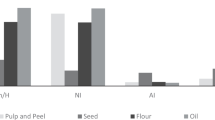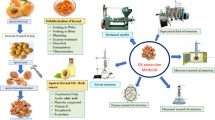Abstract
This paper considers palm oil, palm kernels, and peanuts imported to the U.K., mainly from Nigeria. The origin of the oil palm and the peanut plant, their commercial development, and the antiquity of the use of palm oil is discussed, and a brief description is given of the manner in which the crops are handled and processed in West Africa.
By the control of lipolysis, due to 1) the presence of lipases in the fruit, 2) chemical hydrolysis, and 3) the lipolytic action of moulds, oil with about 1% fatty acid may be marketed; most Nigerian peasant-produced oil is below 5%. It is mainly edible, but not easily bleached. This is due to oxidation caused by lipoxidases in the fruit, and oxidation by air catalysed in the presence of metals, especially iron. By control of these factors Nigerian oil of excellent bleach-ability may be prepared.
Palm kernels suffer from acidity and browning. Development of acidity is ascribed to kernel breakage with concomitant development of lipolytic moulds and bacteria. Non-enzymic browning is mentioned.
Nigerian peanut oil from the 1951-52 crop averaged 5.63% free fatty acid content (FFA) compared with 1.46% for 1960-61. This improvement is largely due to improved methods of decortication. Some preliminary studies are reported concerning mould growth on kernels stored under West African conditions and work on toxicity associated with certain batches of peanuts, caused by the mould,Aspergillus flavus.
Similar content being viewed by others
References
Friedel, M. C. Compt. Rend.124, 648–653 (1897).
Mauny, Raymond, “Tableau Geographique de l'ouest Africain au Moyen Age.≓ Memoires de l'Institut Francais d'Afrique-Noire No. 61, Ifan-Dakar, 1961, pp. 248, 429.
Fickendey, E., and H. M. Blomendaal, “Olpalme,≓ Walter Bangert, Hamburg, 1929, p. 97.
Hakluyt “Voyages≓ (A description of a voyage to Benin in 1588- 89, by James Welsh), Dent, London, Vol. 4, 1927, p. 297.
Chevalier, A., “Documents sur le Palmier à Huile,≓ Les Végétaux Utiles de L'Afrique Tropicale Francaise, Fasc. VII, Paris, 1910.
Seeman, B., “Popular History of the Palms,≓ London, 1856, p. 191.
Commonwealth Economic Committee, “Vegetable Oils and Oilseeds,≓ No. 12, Her Majesty's Stationery Office, London, 1962.
Bauhin, J., “Historia Plantarum Universalis,≓ Part I, Liber 3, Cap. 159, 1650.
Jacquin, N. J., “Seleetarum Stirpuim Americanarun Historia,≓ 1763, p. 280.
Adam, J., “Le Palmier à Huile.≓ Paris, 1910.
Johnson, R. M., and W. D. Raymond, Colonial Plant Animal Prod.4, 14–23 (1954).
“Investigations into the African Oil Industry,≓ Bull. Imp. Inst.7, 357-394 (1909);11, 206 (1913);15, 57 (1914).
“The Cultivation of the African Oil Palm with Special Reference to the East Indies,≓Ibid. 18, 209-252 (1920).
Farquhar, J. H. F., “The Oil Palm,≓ Crown Agents, London, 1913.
“The Oil Palm: Its Culture, Manuring and Utilization,≓ International Potash Institute, Berne, 1957.
Proceedings of the Conference on Oil Palm Research, held at the Oil Palm Research Institute, Colonial Office, H.M.S.O., London, 1949.
Cook, O. F., Nat. Hort. Mag. 10-31 (1940).
Cook, O. F., Sci. Monthly, Lond.54, 577–580 (1942).
Chevalier, A., Rev. Bot. Appl.14, 187 (1934).
Waterston, J. M., J. W. African Inst. Oil Palm Res.I, 24–59 (1953).
Faulkner, O. T., and C. S. Lewin, “Native Methods of Preparing Palm Oil—II,≓ Second Ann. Bull. Dep. Agr., Nigeria, 3-17 (1923).
Faulkner, O. T., “Palm Oil Control Factories,≓ First Ann. Bull. Dep. Agr., Nigeria, 18-27 (1922).
Gray, J. E., “Native Methods of Preparing Palm Oil,≓Ibid. 29-50 (1922).
Barnes, A. C., “Native Methods of Preparing Palm Oil—III,≓ Third Ann. Bull. Dep. Agr., Nigeria, 3-10 (1924).
Barnes, A. C., Bulletin of the Dept. of Agriculture, 1924, and Second Bulletin, 1925.
West African Institute for Oil Palm Research Quarterly Progress Report No. 39 (Dec. 1961) Hand Press Operation Report.
Raymond, W. D., J. Inst. Agr. Eng.3, 74 (1960).
Ames, G. R., W. D. Raymond, and J. B. Ward, J. Sci. Food Agr.4, 194–202 (1960).
“Variations des Characteristiques de Certaines Huiles de Palme,≓ Ser. Sci. Inst. Rech. Huiles, No. 9, Paris, 1956. “Etudes sur le Oaro- tene de l'Huile de Palme,≓ Ser. Sci. Inst. Rech. Huiles, No. 8, Paris, 1955.
Fickendey, E., Tropenpflanzer14. 560–570 (1910).
Coursey, D. G., Oléagineux15, 623–30 (1960).
Coursey, D. G., and H. W. O. Eggins,Ibid.16, 227–33 (1961).
Eckey, E. W., “Vegetable Fats and Oils,≓ Reinhold Publishing Corporation, New York, 1954, p. 339–343.
Commonwealth Economie Committee, “Vegetable Oils and Oilseeds,≓ No. 12, Her Majesty's Stationery Office, London, 1962, pp. 130-142.
Coursey, D. G., E. A. Simmons, and Ann Sheridan, Private Communication, May, 1962.
Coursey, D. G., Oléagineux16, 385–8 (1961).
W.A.S.P.R.U. Annual Report, 28 (1959).
West African Institute for Oil Palm Research Quarterly Progress Report No. 36, p. 9; No. 38, p. 8.
McWeeny, D. J., Private Communication, July 1962.
Some Observations on the Discolouration of Palm Kernels,≓ W.A.S.P.R.U. 1960.
Dubard, Marcel, Bull. Mus. Hist. Nat., Paris, 340 (1960).
Badami, V. K., J. Mysore Agr. Expt. Union15, 141–154 (1935).
Commonwealth Economic Committee “Vegetable Oils and Oilseeds,≓ Her Majesty's Stationery Office, No. 12, London, 1962, pp. 24-44.
Adam, J., “L'Arachide,≓ Paris, 1908.
“The Peanut, the Unpredictable Legume,≓ National Fertilizer Association, Washington, D. C., 1951.
Raymond, W. D., Colonial Plant Animal Prod. 2, 265–274 (1951).
Annet, M. E., “Le Probleme du decortiquage des Arachides en Afrique Occidentale FranÇoise,≓ Rev. Bot. Appl.11, 730–8 (1931).
Raymond, W. D., Colonial Plant Animal Prod.4, 200–235 (1954).
Davey, P. M., D. W. Hall, P. L. K. Coveney, W. D. Raymond, and J. A. Squires, Trop. Sci.1, 296–307 (1959).
Whiston, A., R. S. Hay, and W. D. Raymond, Trop. Sci.1, 149- 181 (1959).
Ramanathan, K. M., R. Nataragan, and D. M. Samuel. Indian Oilseeds J. 6, 95 (1962).
Blount, W. P., Turkeys, 9, 52 (1961).
Asplin, F. D., and R. B. A. Carnaghan, Vet. Bec.73, 1212 (1961).
Loosemore, R. M., and L. M. Markson,Ibid.73, 813 (1961).
Carnaghan, R. B. A., and K. Sargeant,Ibid.73, 726–727 (1961).
Sargeant, K., Ruth Allcroft, and R. B. A. Carnaghan,Ibid.73, 865 (1961).
Sargeant, K., J. O'Kelly, R. B. A. Carnaghan, and Ruth Allcroft,Ibid.73, 1219–1223 (1961).
Sargeant, K., A. Sheridan, J. O'Kelly, and R. B. A. Carnaghan, Nature192, 1096–1097 (1961).
Van der Zijden, A. S. M., W. A. A. Blanche Koelensmid, J. Boldingh, C. B. Barrett, W. O. Ord, and J. Philp,195, 1060- 1062 (1962).
Nesbitt, Brenda F., J. O'Kelly, K. Sargeant, and Ann Sheridan,Ibid.195, 1062–1063 (1962).
De Iongh, H., B. K. Beerthius, E. O. Vles, O. B. Barrett, and W. O. Ord, Biochim. Biophys. Acta65, 548–551 (1962).
Asao, T., G. Büchi, M. M. Abdel-Karder, S. B. Chang, Emily L. Wick, and G. N. Wogan, J. Amer. Chem. Soc.85, 1706 (1963).
Coomes, T. J., and J. C. Sanders, Analyst88, 209–213 (1963).
Broadbent, J. H., J. A. Cornelius and G. Shone,Ibid.88, 214- 216 (1963).
“Toxicity Associated with Certain Batches of Groundnuts.≓ Report of the Interdepartmental Working Party on Groundnut Toxicity Research (London) 1963, Appendix B, p. 2–3.
Milner, M., and W. F. Geddes, “Storage of Cereal Grains and Their Products,≓ edit, by Anderson, J. A., and A. W. Aleock, 165, Amer. Assoc. Cereal Chem., St. Paul, Minnesota, 1956.
Austwick, P. K. C., and G. Ayerst, Chem. Ind., 55-61 (1963).
Author information
Authors and Affiliations
Additional information
Presented at the AOCS meeting, Toronto, 1962.
A station of the Department of Scientific and Industrial Research, 56-62 Gray's Inn Road, London, W. O. 1.
About this article
Cite this article
Hiscocks, E.S., Raymond, W.D. Some problems in improving tropical materials utilized by the United Kingdom oilmilling industry. J. Am. Oil Chemist’ Soc. 41, 224–228 (1964). https://doi.org/10.1007/BF03024655
Received:
Accepted:
Issue Date:
DOI: https://doi.org/10.1007/BF03024655




